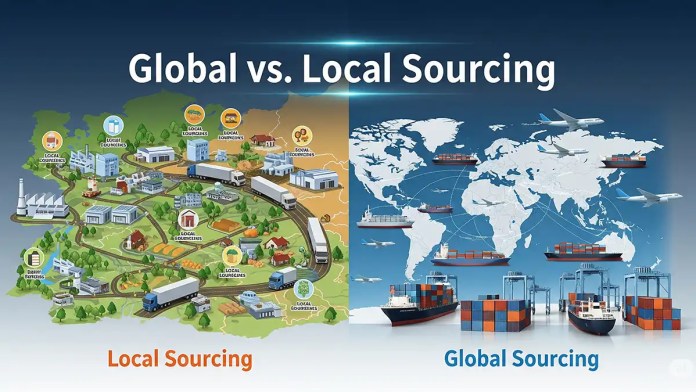The approach you choose, sourcing components locally vs internationally when buying products, can make or destroy your business in the complex world of eCommerce, particularly if you’re a small startup. The most frequent query is: Is it preferable to source domestically or internationally? In actuality, though, it depends on your company. There is no one-size-fits-all solution, so you have to balance the advantages and disadvantages. Are you unsure of those benefits and drawbacks?
We’ll outline the main ones below, so don’t worry. We’ll explore the realm of fulfillment and logistics today. Here is our objective analysis of the benefits and drawbacks of local and international sourcing as a 3PL warehouse. To help you along the road, we’ve also included helpful product-finding advice.
What is Global Sourcing?
A procurement method known as “global” or “international” sourcing looks for goods, products, or services from manufacturers and suppliers across international borders. It is the process of obtaining raw materials, parts, or completed goods from overseas vendors as opposed to depending on domestic vendors.
The Benefits and Drawbacks of Global Sourcing: Sourcing Components Locally vs Internationally
Benefits
Thanks to developments in communication, transportation, and trade agreements that facilitate cross-border trade, global sourcing has grown in popularity in today’s interconnected globe. Businesses use global sourcing for a number of reasons, such as:
|
|
|
|
Drawbacks
Global sourcing does, however, carry a number of dangers and difficulties. Before implementing a worldwide sourcing strategy, businesses need to consider these considerations carefully. The following are a few drawbacks:
|
|
|
Local Sourcing: What is it?
Local sourcing, sometimes referred to as domestic sourcing or local procurement, is a procurement technique whereby a company purchases commodities, products, or services from manufacturers and suppliers situated in the same nation or area as the business’s operations or clientele. To put it simply, local sourcing is sourcing components, materials, or completed goods from domestic suppliers.
Benefits and Drawbacks of Local Sourcing
Benefits
Businesses may choose to source locally on purpose for a number of reasons, such as:
|
|
|
|
|
|
Drawbacks
Although local sourcing has many benefits, there may be certain drawbacks, particularly for companies looking to enter foreign markets:
|
|
|
Select the Better Option for You: Sourcing Components Locally vs Internationally
The particular requirements, objectives, and conditions of your company will determine whether you choose local sourcing or global sourcing. In the end, the sourcing method you choose should complement the goals, values, and clientele of your company. Although there isn’t a single, universal response, there is one that is specific to your company.
Conclusion
The decision between sourcing components locally vs internationally ultimately comes down to creating a supply chain that supports the main objectives of your company rather than trying to identify a single correct solution. International sourcing can result in significant cost savings and give access to a worldwide pool of materials, but local procurement clearly has advantages in timeliness, quality control, and lower risk.
The most strategic and resilient companies frequently use a hybrid model that combines the greatest features of both approaches. You may build a flexible, safe, and strong supply chain that is ready to handle a challenging and constantly shifting market by carefully balancing local partners for essential needs and international suppliers for affordable components.
FAQ
What is the difference between local and international sourcing?
Locally sourced goods do not have to be shipped long distances, reducing lead times and risks of disruption.
What is the difference between domestic and international sourcing?
Overall, while domestic procurement focuses on local sourcing and regulations, international procurement requires a broader perspective and careful navigation of global supply chains and regulations.
What is the difference between the global and local sourcing rules?
Local sourcing involves obtaining goods or services from nearby suppliers, supporting local economies, and promoting sustainability. Global sourcing seeks suppliers from different countries for cost efficiencies and diverse markets.
What is an example of local sourcing?
3.9A – Local Sourcing
For example, buying local products, trying to trade with other local businesses, and building local community movements around sustainability issues.
What are the benefits of local sourcing?
Reduced supply chain risks:
Local sourcing helps to reduce supply chain risks, as supply chains are often shorter when choosing to source locally.
Also Read:




